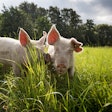
Farmers looking to boost their earnings should consider using feed additives to reduce emissions of enteric methane and selling the carbon credits that result, according to Jackie Klippenstein, senior vice president and chief government affairs and industry relations officer for Dairy Farmers of America.
In order to set scientifically verified emissions goals, Dairy Farmers of America conducted a study to assess the carbon footprint of the dairy industry, Klippenstein told members of the American Farm Bureau Association at their annual convention held in mid-January in Salt Lake City. The study generated a lifecycle assessment — an analysis of all carbon emissions associated with milk production — that suggests the bulk of the dairy industry's carbon footprint is associated with manure, feed production and enteric emissions of methane created in the ruminant digestive process.
While progress in any of the three areas identified by the DFA study could help farmers reduce their carbon footprint, Klippenstein said she was particularly interested in feed additives that suppress enteric methane on account of their accessibility.
“What gets me excited about the feed part is other technologies won't make sense on a 200-cow dairy,” she said. “It seems like a feed strategy is something everyone can incorporate ... so I am excited about delivering something that all farms can benefit from.”
While many additives marketed specifically to reduce enteric methane are not approved for use in the U.S., Klippenstein said DFA has been engaged with regulators on the process and has received signals that approval seems likely.
Farmers who can verify that they have reduced carbon emissions from any of these sources can potentially sell carbon credits on markets such as Athian, where the Dairy Farmers of America recently made its first purchase of carbon credits from a livestock producer. That purchase, Klippenstein said, will help Dairy Farmers of America reach its goals of reducing greenhouse gas emissions by 30% by 2030.
And other corporations are looking to make similar purchases to offset their own carbon emissions, Klippenstein said, though she noted that carbon credits are not the only potential vehicle for farmers to earn a return on projects to reduce emissions. In addition to government funds and grants, she said dairy farmers in the U.S. have brought in some US$150 million from customers looking to fund projects that reduce carbon emissions.
Dairy Farmers of America has taken an interest in emissions reductions because, as a milk marketing cooperative, having a lower carbon footprint gives its members a potential competitive advantage — including in international markets where certain emissions criteria may be mandatory, Klippenstein said.
Klippenstein said she believes other ruminant species could see similar benefits from using feed additives for methane suppression. But because emissions reductions must be verified by a third party, she said producers who raise other species will first need to complete a lifecycle emissions assessment similar to the study completed by DFA. Non-ruminants could also benefit from such studies, but may need to look to other sources of carbon emissions — such as the carbon footprint of the feed itself — in order to achieve verifiable reductions in emissions, Klippenstein said.














